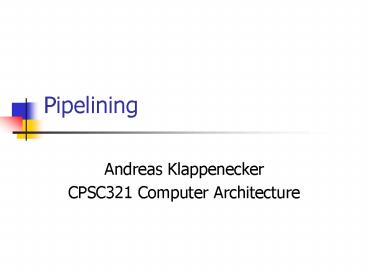Pipelining - PowerPoint PPT Presentation
Title:
Pipelining
Description:
What is the average speed-up for. pipelined versus non-pipelined execution ... MIPS Appreciation Day. All MIPS instructions have the same length ... – PowerPoint PPT presentation
Number of Views:15
Avg rating:3.0/5.0
Title: Pipelining
1
Pipelining
- Andreas Klappenecker
- CPSC321 Computer Architecture
2
Basic Idea
3
Time Required for Load Word
- Assume that a lw instruction needs
- 2 ns for instruction fetch
- 1 ns for register read
- 2 ns for ALU operation
- 2 ns for data access
- 1 ns for register write
- Total time 8 ns
4
Non-Pipelined vs. Pipelined Execution
5
Question
- What is the average speed-up for
- pipelined versus non-pipelined execution
- in case of load word instructions?
Average speed-up is 4-fold!
6
Reason
- Assuming ideal conditions
- time between instructions (pipelined)
- time between instructions (nonpipelined)
- number of pipe stages
7
MIPS Appreciation Day
- All MIPS instructions have the same length
- gt simplifies the pipeline design
- fetch in first stage and decode in second stage
- Compare with 80x86
- Instructions 1 byte to 17 bytes
- Pipelining is much more challenging
8
Obstacles to Pipelining
- Structural Hazards
- hardware cannot support the combination of
instructions in the same clock cycle - Control Hazards
- need to make decision based on results of one
instruction while other is still executing - Data Hazards
- instruction depends on results of instruction
still in pipeline
9
Structural Hazards
- Laundry examples
- if you have a washer-dryer combination instead of
a separate washer and dryer, - separate washer and dryer, but roommate is busy
doing something else and does not put clothes
away sic! - Computer architecture
- competition in accessing hardware resources,
e.g., access memory at the same time
10
Control Hazards
- Control hazards arise from the need to
- make a decision based on results of an
- instruction in the pipeline
- Branches What is the next instruction?
- How can we resolve the problem?
- Stall the pipeline until computations done
- or predict the result
- delayed decision
11
Stall on Branch
- Assume that all branch computations are done in
stage 2 - Delay by one cycle to wait for the result
12
Branch Prediction
- Predict branch result
- For example, predict always that branch
- is not taken
- (e.g. reasonable for while instructions)
- if choice is correct, then pipeline runs at full
speed - if choice is incorrect, then pipeline stalls
13
Branch Prediction
14
Delayed Branch
15
Data Hazards
- A data hazard results if an instruction depends
on the result of a previous instruction - add s0, t0, t1
- sub t2, s0, t3 // s0 to be determined
- These dependencies happen often, so it is not
possible to avoid them completely - Use forwarding to get missing data from internal
resources once available
16
Forwarding
- add s0, t0, t1
- sub t2, s0, t3
17
Single Cycle Datapath
18
Pipelined Version































